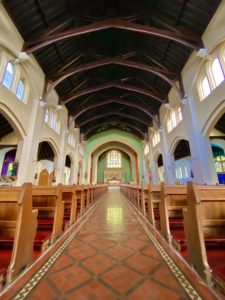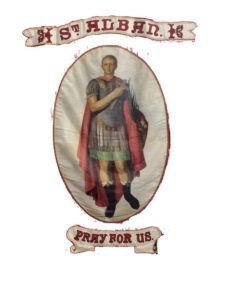
History of St. Alban on the Moors 1880-2020 In the year 1880 the flat land just outside the town of Cardiff, known as the East Moors, was, with the exception of a few cultivated fields belonging to the farms of Pengam and Splott, a marshy waste stretching its dreary length along the shores of the Bristol Channel, the monotony of the scene being broken only by ditches and gates. During the 1880s this low-lying wilderness was developed by building contractors, who mapped out a small section into streets and a bewildering maze of houses, shops, taverns and Board Schools. Land was secured for the erection of a Catholic School-Chapel. Fr. Hayde gave Fr. Bailey the task of collecting funds for the new building, which first opened in 1891.
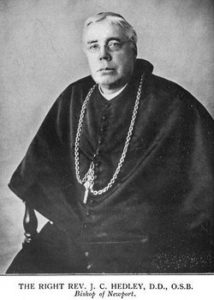
Blessing of the Chapel by Bishop Hedley on 24th June 1891 At this opening service the Bishop celebrated the first High Mass in the new St. Alban’s Mission, and offered it up for the welfare of those who aided in the establishment of the Mission. The Marquess and the Marchioness of Bute were present at the Blessing of the new chapel. In the chapel the altar and reredos were those which used to be in the Lady Chapel at St. Peter’s. On the wall over the back of the altar were the Crucifix and the figures of Our Lady and St. John the Evangelist, which originally graced the old church of St. David, the original Catholic foundation in Cardiff. The ground floor of the building was used as an Infants’ School under the direction of the Headmistress, Mrs. Sullivan, aided by a young girl of about 14 years of age, a pupil teacher named Miss Byrne.
The Iron Church
In August , 1897, the upper floor had to be given up to school purposes, and it was no longer convenient to hold Church Services there. Not only that, but there were now 1,000 Catholics resident in the Moors (owing to the opening of the Cardiff Dowlais Works), whilst the seating capacity of the School-Chapel was only 80. With the consent of the Bishop, Father Bailey made an appeal for funds for a new church. The Marquess of Bute, in his magnanimity, provided the new Iron Church, which was opened on Tuesday, November 30th, 1897. From this time onwards two Masses were said at St. Alban’s, one at 8.30am as previously, and a second one at 10.30am. In the afternoon there was Children’s Catechism and Benediction at 4 o’clock, as well as public Vespers. Father Bailey died on March 12th, 1898, only a few months after seeing this further advancement of the Mission he had served so well. He had been a member of the Institute of Charity for 46 years.
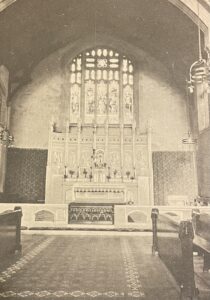
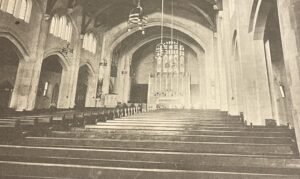
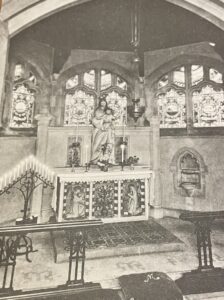
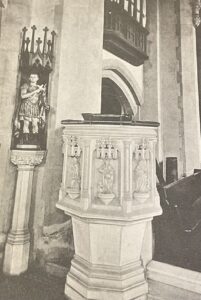
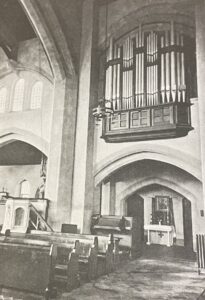
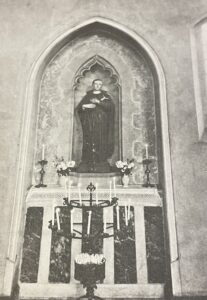
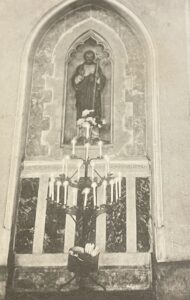
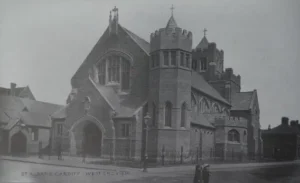
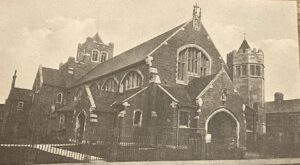
The First Resident Priest Father T. Nolan succeeded Fr. Bailey as Priest-in-Charge of the Splott district, and in July, 1898, he had the happiness of seeing the first Confirmation of St. Alban’s children in their own church on the occasion of the Bishop’s first official visitation of the Mission.The work of consolidation went on apace, and on September 13th, 1898, Father Nolan took up residence in a couple of rooms in the house of Mrs. Kranz, 37 Moorland Road. Conditions were not satisfactory from a parochial point of view, and in a few weeks Fr. Nolan went to live with the Belt Family at 212 Carlisle Street. Fr. Nolan remained as the sole Resident priest for a year. Fr. Hayde was then appointed as Rector, with Fr. Nolan as assistant, and the Presbytery was established at 177-179 Carlisle Street. Here the priests lived, except for a brief sojourn at 104 Splott Road, until the new Presbytery was built next to the Church in 1927.
The Permanent Church After two years Fr. Hayde returned to St. Peter’s. A year later Fr. Nolan left and was succeeded as Rector by Fr. Palmer, who had the great courage and vision to build the present grand church in 1911. We must pay a tribute of great praise to Fr. Owen McCusker for the energy and zeal with which he collected money for the erecting of the new church. It was his able support which enabled Father Palmer to execute his noble design. In planning the church Mr. F.R. Bates, A.R.I.B.A., of Newport, designed a building which ranks among the most imposing in the city. It is designed in the purest perpendicular style. The contract for this building to seat 600 was secured by Mr. James Allan, of Cardiff. Externally the walls are of dressed blue pennant stone, with Bath stone dressings, the roof of green Llantilo slates. There is a tower containing eight tubular bells, and an octagonal tower stands at the south of the west entrance. A cleristory containing fifteen lights stands over an arcade of five bays spaced by octagonal columns. Outside the arcade is an exceptionally wide ambulatory. The High Altar, the gift of Lord Ninian Crichton-Stuart, is of Bath stone, panelled with green Cippolino marble. The two statues at the Chancel Arch, of Our Lady of Lourdes and of St. Alban in Roman uniform, are the gift Father Fennell made to the parish in exchange for the old Iron Church. (The Iron Church was removed to the Heath and became the new St. Joseph’s.) The pulpit was given by the men of the Blast Furnace Dept., G.K.B. Cardiff Dowlais Works. The Lady Altar is a valuable piece of work by Pugin, and comes from St. Marie’s, Rugby. The statue of Our Lady in the Lady Chapel was given by Fr. Bailey to Fr. Nolan, and the Pieta by Bishop Hedley to Fr. Palmer. The large Crucifixion Set on the West Wall is the one referred to above and came from old St. David’s. Bishop Hedley opened the new St. Alban’s on Sunday July 16th, 1911, the spacious lay-out of the sanctuary and chancel-choir lending a dignity to the Pontifical Mass which was an unaccustomed spectacle for those who assisted. St. Alban’s has ever since maintained the fullest splendour of the liturgical ceremonies.
Later Developments Since that time the outstanding events have been the building of the new Presbytery and a new wing to the school during the Rectorship of Fr. Mason: the gift of a winning ticket in the Irish Sweepstakes to the parish during the rectorship of Fr. Ottway, so that the enormous debt of some £10,000 could be wiped out: the installation of a central heating apparatus, stations of the cross, and stained glass windows, all during Fr. Ottway’s Rectorship. During the war slight damage was done to the parish buildings, and they gradually fell into disrepair. Government controls have hampered the progress of recovery, but it has been possible during the last couple of years to put the church and school buildings into as good a condition as ever they were. Two new temporary class-rooms have been added to the school buildings. As soon as possible a Parish Hall will be erected for the accommodation of the various parish societies, especially the large Youth Movement, at present housed in the local Labour Party Hall. What a vast change has come over the East Moors since those days of the early eighties, when it was a mixture of farm and tide-fields. The parish has a Catholic population of 4,000 souls served by four resident priests and possesses a magnificent Church as well as the substantial school built by Fr. Bailey, the pioneer of the parish. Let us of this generation pray for the souls of those great forebears who built the parish, and in meeting the difficulties of the future take courage and hope from recalling their valiant sacrifices so wonderfully crowned with success.
